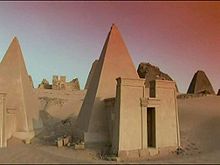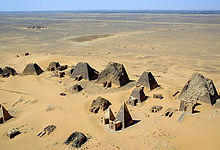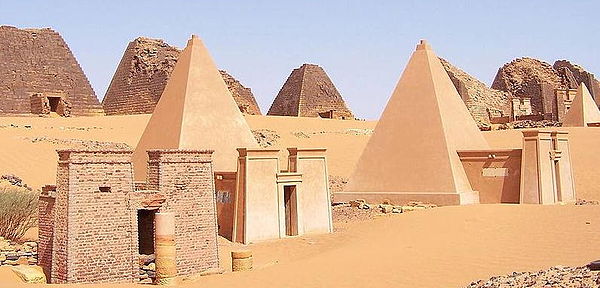- Nubian pyramids
-
Nubian pyramids are pyramids that were built by the rulers of the Kushite (centered around Napata and Meroe) and Egyptian kingdoms. Prior to the Kushites building these pyramids (which are located in modern day Sudan), there had been no pyramid construction in Egypt and the Nile Valley for more than 500 years.
The area of the Nile valley known as Nubia, which lies within present day Sudan, was home to three Kushite kingdoms during antiquity. The first had its capitol at Kerma from (2600–1520 BC). The second was centered around Napata from (1000–300 BC). Finally, the last kingdom was centered around Meroë (300 BC–AD 300).
Kerma was Nubia's first centralized state with its own indigenous forms of architecture and burial customs. The last two kingdoms, Napata and Meroe, were heavily influenced by ancient Egypt; culturally, economically, politically, and militarily. The Kushite kingdoms in turn competed strongly with Egypt. In fact, during the late period of Ancient Egyptian history, the rulers of Napata conquered and unified Egypt herself. The Napatans ruled as the pharaohs of the Twenty-fifth Dynasty. The Napatan domination of Egypt ended with the Assyrian conquest in 656 BC.
Contents
The Pyramids
Approximately 220 pyramids were eventually constructed at three sites in Nubia over a period of a few hundred years to serve as tombs for the kings and queens of Napata and Meroë. The first of these was built at the site of el-Kurru, including the tombs of King Kashta and his son Piye (Piankhi), together with Piye's successors Shabaka, Shabataka, and Tanwetamani. Fourteen pyramids were constructed for their queens, several of whom were renowned warrior queens. This can be compared to approximately 120 much larger pyramids that were constructed in Ancient Egypt over a period of 3000 years.
Later Napatan pyramids were sited at Nuri, on the west bank of the Nile in Upper Nubia. This necropolis was the burial place of 21 kings and 52 queens and princes including Anlami and Aspelta. The bodies of these kings were placed in huge granite sarcophagi. Aspelta's weighed 15.5 tons, and its lid weighed four tons.[1] The oldest and largest pyramid at Nuri is that of the Napatan king and Twenty-fifth Dynasty pharaoh Taharqa.
The most extensive Nubian pyramid site is at Meroë, which is located between the fifth and sixth cataracts of the Nile, approximately one hundred kilometres north of Khartoum. During the Meroitic period, over forty queens and kings were buried there.
The physical proportions of Nubian pyramids differ markedly from the Egyptian edifices: they are built of stepped courses of horizontally positioned stone blocks and range from approximately six to thirty metres in height, but rise from fairly small foundation footprints that rarely exceed eight metres in width, resulting in tall, narrow structures inclined at approximately seventy degrees. Most also have offering temple structures abutting their base with unique Kushite characteristics. By comparison, Egyptian pyramids of similar height generally had foundation footprints that were at least five times larger and were inclined at angles of between forty and fifty degrees.
All of the pyramid tombs of Nubia were plundered in ancient times, but wall reliefs preserved in the tomb chapels reveal that their royal occupants were mummified, covered with jewellery and laid to rest in wooden mummy cases. At the time of their exploration by archaeologists in the nineteenth and twentieth centuries, some pyramids were found to contain the remains of bows, quivers of arrows, archers' thumb rings, horse harnesses, wooden boxes, furniture, pottery, colored glass, metal vessels, and many other artifacts attesting to extensive Meroitic trade with Egypt and the Hellenistic world.
A pyramid excavated at Meroë included hundreds of heavy items such as large blocks adorned with rock art and 390 stones that comprised the pyramid. A cow buried complete with eye ointment was also unearthed in the area to be flooded by the Meroë Dam, as were musical rocks that were tapped to create a melodic sound.[2]
Cemeteries
- The royal cemetery at el-Kurru. Buried here were Kashta, Piye, Tantamani, Shabaka and several queens are buried in pyramids at El-Kurru.
- The Pyramids of Meroe (Begarawiyah). Dating to the Meroitic period. Pyramids date to 720 - 300 BCE (South Cemetery) and ca 300 BCE to about 350 AD (North Cemetery)
- The royal cemetery at Nuri. King Taharqa and other royals from the kingdom of Napata are buried at Nuri.
- Pyramids of Gebel Barkal
See also
- Ancient Egypt
- Candace of Meroë
- Kingdom of Kush
- List of megalithic sites
- Meroë
- Nubia
- Nubian architecture
References
- ^ Lehner, Mark (1997). The Complete Pyramids. Thames and Hudson. p. 196-197. ISBN 9780500050842. http://books.google.com/books?id=dMF4QgAACAAJ.
- ^ Adams, Stephen (16 October 2008). "Ancient Egypt had powerful Sudan rival, British Museum dig shows". The Telegraph. http://www.telegraph.co.uk/news/worldnews/africaandindianocean/sudan/3209644/Ancient-Egypt-had-powerful-Sudan-rival-British-Museum-dig-shows.html.
External links
- Pyramids of Nubia – A site detailing the three major pyramid sites of ancient Nubia
- Nubian Pyramids – A site featuring numerous photographs of the pyramids at Meroë
- Aerial Photographs of Sudan – A site featuring spectacular aerial photographs of the pyramids and temples at el-Kurru, Nuri, and Meroë
- Voyage au pays des pharaons noirs Travel in Sudan and notes on the Nubian history (French)
Coordinates: 16°56′18″N 33°44′55″E / 16.938205°N 33.748690°E
Categories:- Archaeological sites in Sudan
- Nubia
- Kingdom of Kush
- Pyramids
- African architecture
Wikimedia Foundation. 2010.



